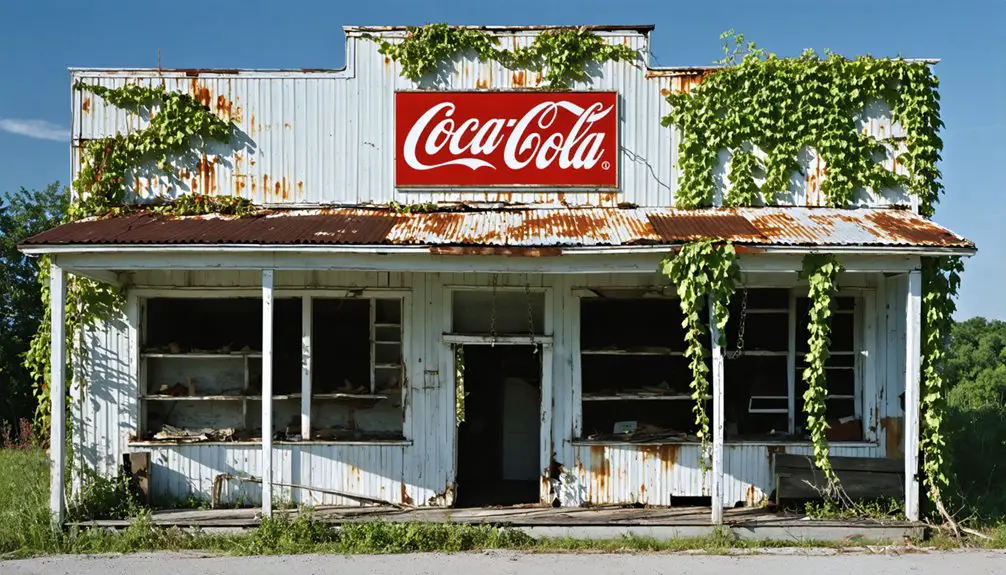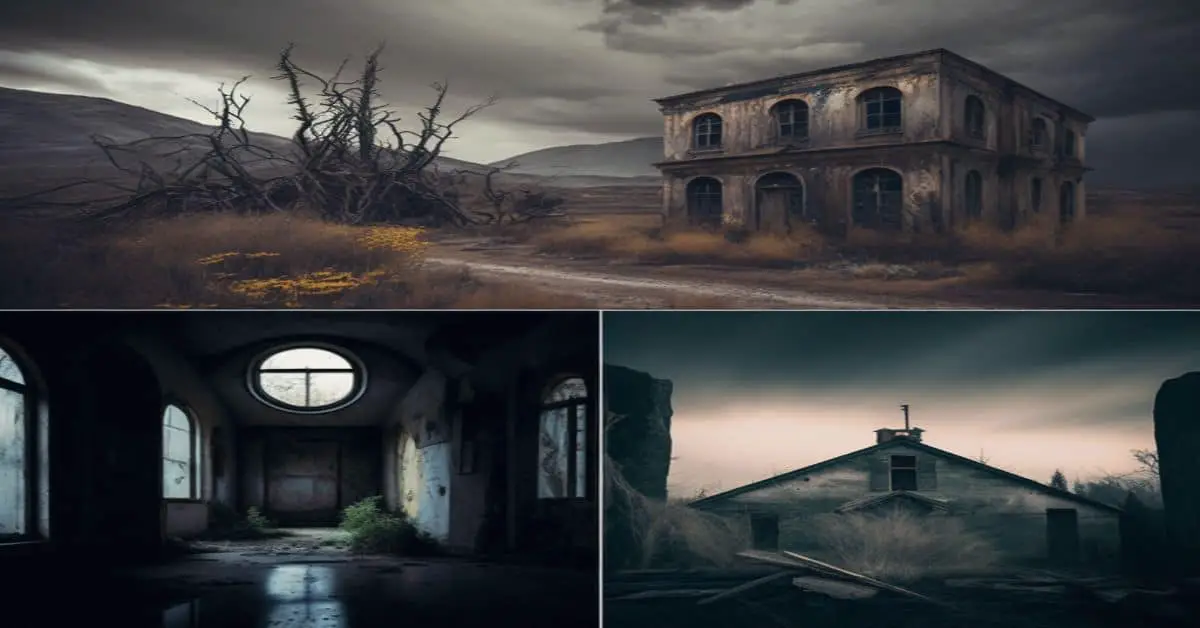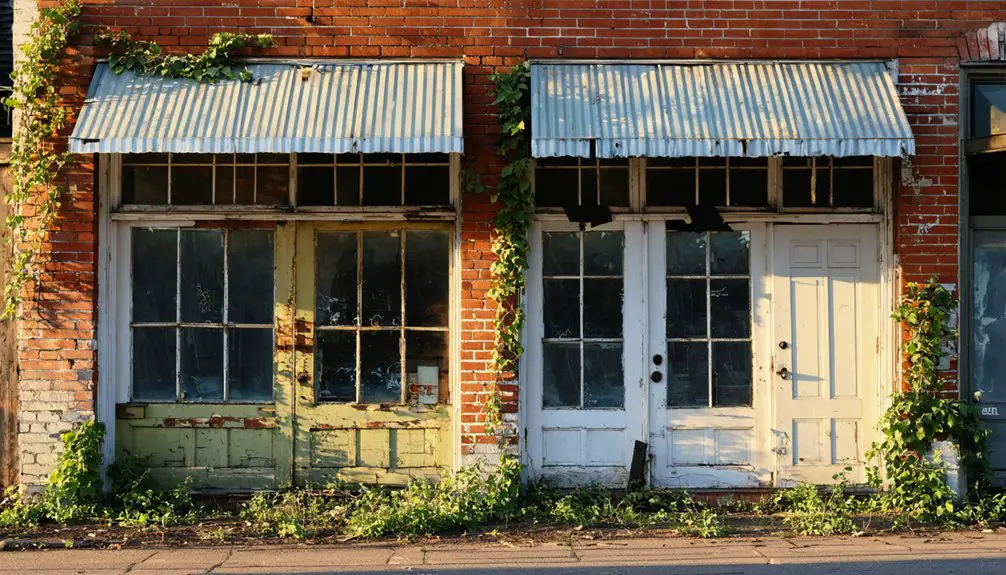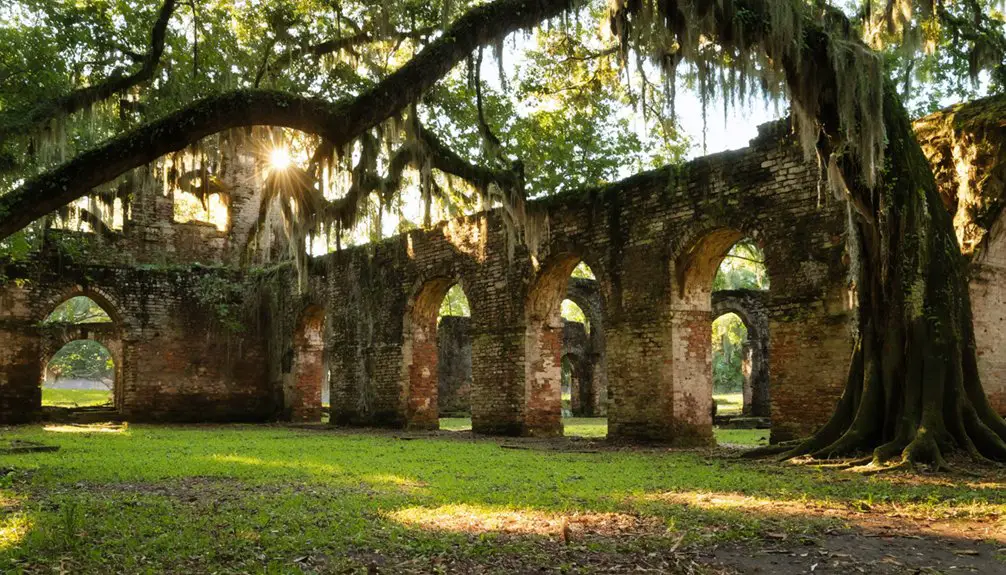You’ll find Judson, North Carolina hidden beneath Fontana Lake‘s waters since 1944. This once-vibrant mountain community of 600 residents featured a bustling sawmill, shops, and post office before the TVA’s wartime dam project forced evacuation. During winter drawdowns, you can spot building foundations, gravestones, and remnants of the old bridge emerging from the depths. The town’s submerged secrets and haunting mysteries await those who venture to explore its watery grave.
Key Takeaways
- Judson was a thriving mountain community of 600 residents in North Carolina that was submerged by Fontana Lake in the 1940s.
- The town was forcibly evacuated for the Fontana Dam project during World War II, with residents receiving $37.76 per acre for their land.
- Remnants of Judson, including building foundations, gravestones, and sawmill ruins, become visible during annual winter lake drawdowns.
- The submerged Mount Carmel Cemetery and other town structures create an underwater archaeological site that documents early Appalachian life.
- Judson’s flooding displaced 2,311 families and erased a complete mountain community, leaving only underwater remnants of its existence.
Life Before the Flood: a Glimpse Into Historic Judson
Before the waters of Fontana Lake submerged its streets forever, Judson stood as a thriving mountain community of 600 residents along the Little Tennessee River.
You’d find a bustling sawmill at the heart of the town’s timber-based economy, while local shops and a post office served as gathering spots where neighbors exchanged news and maintained their rural traditions.
Life in Judson reflected the independent spirit of Appalachian culture, with community life centered around the rhythms of forest and river. Similar to other place name disambiguation entries, the town left a lasting historical legacy.
You could witness the close-knit fabric of mountain society, where families worked the forested hills and fertile valleys.
The town’s daily routines, from small-scale farming to timber processing, embodied the self-sufficient nature of early 20th-century rural North Carolina settlements. The community was sold to the government in the 1930s to make way for hydroelectric power and the creation of the Great Smoky Mountains National Park.
The Coming of Fontana Dam: A Town’s Final Days
When Pearl Harbor thrust America into World War II in December 1941, Congress swiftly authorized the construction of Fontana Dam just nine days after the attack.
The wartime urgency meant you’d witness dramatic changes as the TVA launched this emergency initiative to power aluminum production for aircraft and support nuclear research at Oak Ridge. The dam would become the tallest eastern dam, standing an impressive 480 feet high.
- Over 5,000 workers descended on the remote mountain site
- Three 8-hour shifts operated around the clock
- Your hometown of Judson faced forced evacuation
- The government acquired land for just $37.76 per acre
- 2,311 families had to relocate as waters would soon rise
The Fontana construction transformed your peaceful mountain community into a bustling wartime project. The new worker camp featured a beauty parlor and movie theater to support the growing population.
You’d watch as 2.8 million cubic yards of concrete reshaped the landscape, knowing your town would soon disappear beneath the rising waters.
Beneath the Waters: What Remains Today
Three distinct types of remnants tell Judson’s underwater story today: building foundations that emerge during low water, partially exposed gravestones near the shoreline, and structural ruins from the town’s sawmill.
When Fontana Lake’s levels drop during annual drawdowns, you’ll find these submerged structures revealing themselves, offering rare glimpses into the past.
Local folklore speaks of unraised graves beneath the waters, though official records show most cemeteries were relocated. You’ll need permission to explore these sites, whether by shore or underwater.
The sunken remains represent crucial cultural heritage from early 20th-century Appalachian life, when about 600 residents called this mountain town home.
Today, historians and enthusiasts document these artifacts during low-water periods, preserving Judson’s story for future generations.
Stories of Displacement and Broken Promises
You’d be hard-pressed to find a more poignant example of displaced communities than Judson’s 600 residents, who were forced to abandon their homes, businesses, and way of life in the early 1940s for the Fontana Dam project.
The government’s promise to build a road maintaining access to family properties and ancestral burial grounds resulted in the infamous “Road to Nowhere,” with only seven miles completed before abandonment.
The scattered former residents lost not just their physical town, but their tight-knit community bonds and cultural traditions, which had been anchored to a place that now lies beneath Fontana Lake’s waters. Like many who find content unavailable, these displaced residents were left searching for alternatives to maintain their connections.
During periods of low water levels, visitors can still glimpse remnants of the past as old cars and bridge emerge from the depths.
Forced Exodus From Home
During the forced exodus of 1944, approximately 600 residents of Judson faced an abrupt and life-altering displacement as their town was submerged beneath the rising waters of Fontana Lake.
The displacement effects rippled through every aspect of their lives, shattering generations of community resilience built in this Appalachian town. The Whiting Manufacturing Company had provided jobs and housing for over 400 workers before the flooding forced operations to cease.
- You’d lose your home with little warning or time to plan your next steps
- Your family’s burial grounds would become inaccessible, cut off from ancestral connections
- Your local businesses, post office, and sawmills would vanish underwater
- Your traditional hunting and fishing grounds would disappear forever
- Your tight-knit community networks would scatter as families relocated separately
The government’s promise of a new road to access your former lands remained unfulfilled, leaving you permanently severed from your heritage and ancestral grounds.
Government’s Unfulfilled Road Promise
As part of the Fontana Dam project’s compensation package in 1944, the federal government promised displaced Judson residents a new road that would restore their access to ancestral lands and family cemeteries around the rising lake.
You’ll find that this road restoration project fell drastically short of expectations. Of the planned 30-mile route connecting Bryson City to isolated communities, only seven miles were completed before construction halted.
The abandoned stretch, now known as “The Road to Nowhere,” stands as a stark symbol of unfulfilled governmental accountability. Environmental concerns, budget constraints, and legal disputes derailed the project, leaving displaced families cut off from their heritage.
Despite legal settlements in the early 2000s and continued community advocacy, many gravesites remain inaccessible, and the government’s promise to the people of Judson remains broken. The community eventually received a $52 million settlement instead of the promised road construction.
Lost Community Connections Forever
When federal authorities ordered the evacuation of Judson in the early 1940s, they shattered more than just physical structures – they dismantled an entire social fabric that had defined the region for generations.
You’ll never fully grasp the depth of loss unless you understand what was destroyed:
- A thriving community of 600 residents with deep cultural identity tied to the land
- Multi-generational community bonds forged through shared daily life at local shops and mills
- Ancient Cherokee heritage sites and sacred spaces now beneath the waters
- Family burial grounds and cemeteries, some still submerged despite relocation promises
- Long-established neighborhood connections scattered with no replacement settlements nearby
The displacement didn’t just relocate people – it erased irreplaceable social networks, ancestral ties, and cherished traditions that had bound Judson’s residents together for countless years.
Sacred Ground: The Legacy of Lost Cemeteries
Beneath the tranquil waters of Fontana Lake lies the haunting legacy of Judson’s sacred burial grounds, submerged following the completion of Fontana Dam in 1944.
When water levels drop, you’ll glimpse tombstones and foundations emerging from the depths, offering rare windows into the town’s cultural significance.
Mount Carmel Cemetery, famously featured in Deliverance before its submersion, now rests silently underwater where divers have captured footage of still-readable grave markers.
The unfinished “Road to Nowhere” stands as a broken promise, leaving descendants unable to properly conduct their memorial practices at relocated burial sites.
Local folklore speaks of spiritual presences around these underwater cemeteries, while preservation efforts remain challenging.
During occasional lake drawdowns, you can witness these sacred grounds briefly resurface, reminding us of Judson’s displaced community and their enduring connection to this land.
Exploring Judson’s Underwater Secrets
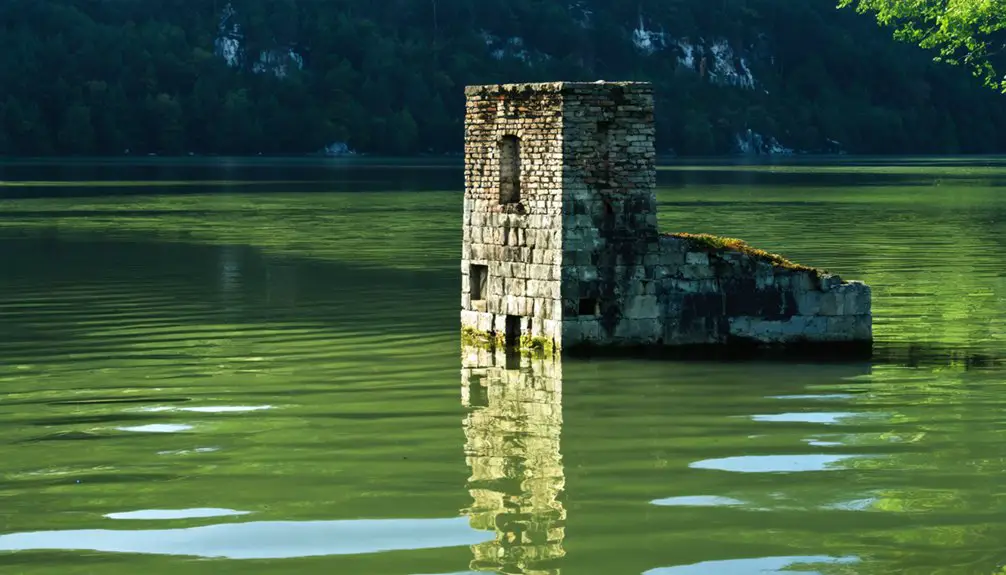
You’ll discover Judson’s submerged history when Fontana Lake’s water levels drop, revealing foundations, an old bridge, and other structural remnants of the once-thriving town.
During clear conditions, you can spot abandoned cars and legible tombstone inscriptions through the depths from pontoon boats that drift above Mount Carmel Cemetery.
As you explore these underwater secrets, whether through permitted scuba excursions or guided boat tours, you’re witnessing a preserved moment in time from when 600 residents left their homes behind in the 1940s.
Diving Into Lost History
Deep within the waters of Fontana Lake lies a treasure trove of history waiting to be discovered.
As you venture into underwater archaeology at Judson’s ghost town exploration site, you’ll find yourself surrounded by remnants of a once-thriving community forced to relocate during World War II.
- Readable tombstones at Mount Carmel Cemetery reveal stories of past residents
- Foundation ruins of homes, shops, and a sawmill paint a picture of daily life
- Historic bridge remains and abandoned vehicles emerge during low water periods
- Cherokee townsites and old forts showcase layers of regional settlement
- Clear water conditions allow glimpses into preserved mid-20th century artifacts
With proper permissions, you can dive these historic waters, documenting a unique slice of American history that now rests beneath the surface, frozen in time since 1944.
Low Water Revelations
Each winter, Fontana Lake’s water levels drop considerably, revealing Judson’s hidden treasures to curious onlookers.
You’ll find the foundations of this once-thriving mountain town emerging from the depths, along with remnants of an old bridge that serves as a silent reflection of the community’s past. During these drawdowns, you can glimpse submerged history in the form of Mount Carmel Cemetery’s weathered markers and other hidden artifacts from pre-1944 life.
When conditions are right, you’ll spot abandoned cars near the shoreline and various structural remains that paint a picture of the 600-person town that once stood here.
Whether you’re exploring by pontoon boat or on foot, these low-water periods offer you a rare window into an Appalachian community forever changed by progress.
Cemetery Mysteries Below Water
Beneath Fontana Lake’s glassy surface lies one of Judson’s most haunting mysteries – the submerged cemetery that once served its 600 residents.
Through clear waters, underwater archaeology reveals preserved tombstones with legible inscriptions, fence posts, and other structural remnants that tell tales of lives interrupted by the 1944 dam project. The creation of Fontana Dam forever changed the landscape of this once-thriving mountain community.
- Ghostly sightings reported near submerged burial sites
- Cherokee artifacts and relics discovered alongside cemetery remains
- Diving expeditions document names and dates on visible headstones
- Local folklore speaks of unsettled spirits in Fontana’s depths
- Unexplained lights and sounds draw paranormal investigators
During low water periods, you can glimpse these underwater monuments to Judson’s past.
What was meant to be temporary submersion has become a permanent memorial to displaced communities, their stories preserved in the lake’s silent depths.
Frequently Asked Questions
What Wildlife Now Inhabits the Underwater Ruins of Judson?
You’ll find an underwater ecosystem teeming with bass, trout, catfish, and invertebrates around the ghost town wildlife habitat, where algae-covered ruins create sheltered spaces for aquatic species’ breeding and foraging.
How Deep Is the Water Covering Most of Judson’s Remains?
Time stands still in the deep, as you’ll find most of Judson’s historically significant remains submerged under 100+ feet of water, with some areas plunging to depths reaching 440 feet.
Were Any Original Judson Buildings Successfully Relocated Before Flooding?
You won’t find any confirmed records of successful building relocations from Judson, despite historic preservation efforts. Relocation challenges and time constraints meant most structures were left behind before the waters rose.
What Artifacts Have Divers Recovered From Judson’s Underwater Site?
You’ll find divers have recovered ceramics, glass bottles, household items, and old tools of historical significance from the underwater site, though most large structures remain untouched on the lakebed.
Do Any Former Judson Residents Still Live in Swain County Today?
From the 600 original residents displaced, you’ll find no documented former residents still living in Swain County today, though community memories persist through descendants who maintain local cemeteries and share family stories.
References
- https://en.wikipedia.org/wiki/Judson
- https://www.blueridgeoutdoors.com/go-outside/sunken-secrets-the-underwater-ghost-towns-of-the-blue-ridge/
- https://blog.vortexboats.com/The-Vanishing-Act-of-Judson–North-Carolina-1-64.html
- https://www.youtube.com/watch?v=muxH8qQTNSw
- https://www.onlyinyourstate.com/state-pride/north-carolina/judson-nc-underwater-ghost-town
- https://coach4aday.wordpress.com/2016/02/04/north-carolina-judson-nc-february-4/
- https://avltoday.6amcity.com/remembering-judson-wncs-underwater-ghost-town
- https://smokymountainnews.com/archives/item/36201-inside-fontana-dam
- https://www.greatsmokies.com/fontana-dam-built-to-support-oppenheimers-manhattan-project/
- https://en.wikipedia.org/wiki/Fontana_Dam
